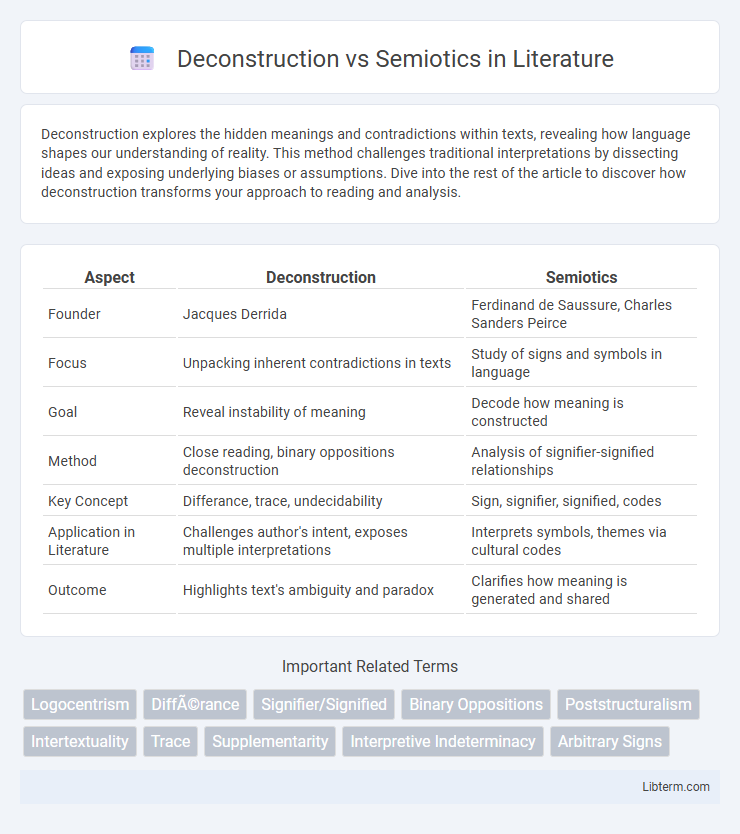Deconstruction explores the hidden meanings and contradictions within texts, revealing how language shapes our understanding of reality. This method challenges traditional interpretations by dissecting ideas and exposing underlying biases or assumptions. Dive into the rest of the article to discover how deconstruction transforms your approach to reading and analysis.
Table of Comparison
| Aspect | Deconstruction | Semiotics |
|---|---|---|
| Founder | Jacques Derrida | Ferdinand de Saussure, Charles Sanders Peirce |
| Focus | Unpacking inherent contradictions in texts | Study of signs and symbols in language |
| Goal | Reveal instability of meaning | Decode how meaning is constructed |
| Method | Close reading, binary oppositions deconstruction | Analysis of signifier-signified relationships |
| Key Concept | Differance, trace, undecidability | Sign, signifier, signified, codes |
| Application in Literature | Challenges author's intent, exposes multiple interpretations | Interprets symbols, themes via cultural codes |
| Outcome | Highlights text's ambiguity and paradox | Clarifies how meaning is generated and shared |
Introduction to Deconstruction and Semiotics
Deconstruction, rooted in the philosophy of Jacques Derrida, dismantles texts to reveal inherent contradictions and the instability of meaning, emphasizing how language shapes perception. Semiotics, pioneered by Ferdinand de Saussure and Charles Sanders Peirce, studies signs and symbols as fundamental components of communication, focusing on the relationship between the signifier, signified, and the interpretation process. Both theories analyze language and meaning but operate differently: deconstruction exposes textual ambiguities, while semiotics decodes the structure and function of signs within cultural contexts.
Historical Origins and Influential Thinkers
Deconstruction emerged in the 1960s primarily through the work of Jacques Derrida, emphasizing the instability of meaning in texts and the inherent contradictions within language. Semiotics, rooted in the late 19th and early 20th centuries, was founded by Ferdinand de Saussure and further developed by Charles Sanders Peirce, focusing on the systematic study of signs and symbols as a means of communication. Both movements shaped critical theory and literary analysis, with deconstruction challenging textual interpretations and semiotics analyzing the structures that create these meanings.
Core Principles of Deconstruction
Deconstruction centers on revealing inherent contradictions and ambiguities within texts, emphasizing the instability of meaning and the fluidity of language. It challenges traditional binary oppositions and hierarchical structures, demonstrating how meaning is deferred through infinite interpretations, a concept known as differance. Unlike semiotics, which studies signs and symbols as stable units conveying meaning, deconstruction interrogates the processes that produce meaning, exposing its inherent instability and the interplay between presence and absence in textual interpretation.
Fundamental Concepts in Semiotics
Semiotics centers on the study of signs and symbols, examining how meaning is created and communicated through signifiers and signifieds, concepts introduced by Ferdinand de Saussure. It emphasizes the relationship between language, images, and cultural context in the interpretation of messages, highlighting codes and conventions that govern understanding. Deconstruction, in contrast, challenges fixed meanings by exposing contradictions and ambiguities within texts, but semiotics provides a structured framework for analyzing meaning construction through sign systems.
Comparing Textual Analysis Approaches
Deconstruction and semiotics offer distinct textual analysis approaches by emphasizing different interpretive frameworks; deconstruction explores the inherent instability and contradictions within texts to reveal hidden meanings and undermine fixed interpretations, while semiotics decodes signs and symbols to understand how meaning is constructed through cultural codes and language systems. Deconstruction critiques binary oppositions and hierarchical structures, aiming to expose the fluidity of language, whereas semiotics systematically categorizes signifiers and signified concepts to uncover how texts generate meaning within social contexts. Both methods analyze language, but deconstruction focuses on disrupting meaning, and semiotics prioritizes the relationship between signs and cultural meanings.
Language, Meaning, and Interpretation
Deconstruction challenges fixed meanings in language by exposing internal contradictions and the instability of signifiers, revealing how interpretation constantly shifts and meaning is never absolute. Semiotics studies signs and symbols as fundamental units of meaning, analyzing the relationship between the signifier (form) and signified (concept) to understand how meaning is constructed in language. Both frameworks emphasize interpretation's fluidity but differ as deconstruction destabilizes meaning through textual analysis while semiotics systematically categorizes meaning-making processes.
Role of Signs and Symbols in Understanding Texts
Deconstruction challenges fixed meanings by exposing contradictions within signs and symbols, revealing the instability of language and the multiplicity of interpretations in texts. Semiotics analyzes the structure and function of signs and symbols, emphasizing how meaning is constructed through the relationship between the signifier and the signified. Together, these approaches deepen understanding of texts by highlighting how signs operate both to convey meaning and to undermine it, complicating interpretation processes.
Deconstruction vs Semiotics in Literary Criticism
Deconstruction in literary criticism emphasizes the inherent instability of language and meaning, revealing contradictions and ambiguities within texts to challenge traditional interpretations. Semiotics analyzes literary works through signs and symbols, exploring how meaning is constructed and communicated within cultural codes. While deconstruction destabilizes textual meaning, semiotics seeks to decode the systems of signification that enable meaning production in literature.
Applications Across Literature, Art, and Media
Deconstruction analyzes texts by exposing hidden contradictions and ambiguities to challenge established meanings, profoundly influencing literary criticism and postmodern art. Semiotics studies signs and symbols as integral elements of communication, facilitating the interpretation of visual art, media narratives, and cultural texts through sign systems. Both frameworks apply to media studies by unraveling layered messages, enabling deeper understanding of ideological constructs in films, advertisements, and digital content.
Contemporary Debates and Future Perspectives
Contemporary debates between Deconstruction and Semiotics center on their divergent approaches to language, meaning, and interpretation, with Deconstruction emphasizing the instability and indeterminacy of texts while Semiotics focuses on the systematic study of signs and symbols. Scholars increasingly explore hybrid frameworks that integrate Derrida's deconstructive methods with Saussurean semiotic principles to address complex cultural and media analyses. Future perspectives suggest a growing interest in applying these theories to digital communication and artificial intelligence, where the fluidity of meaning and sign systems demands nuanced interpretive strategies.
Deconstruction Infographic

 libterm.com
libterm.com